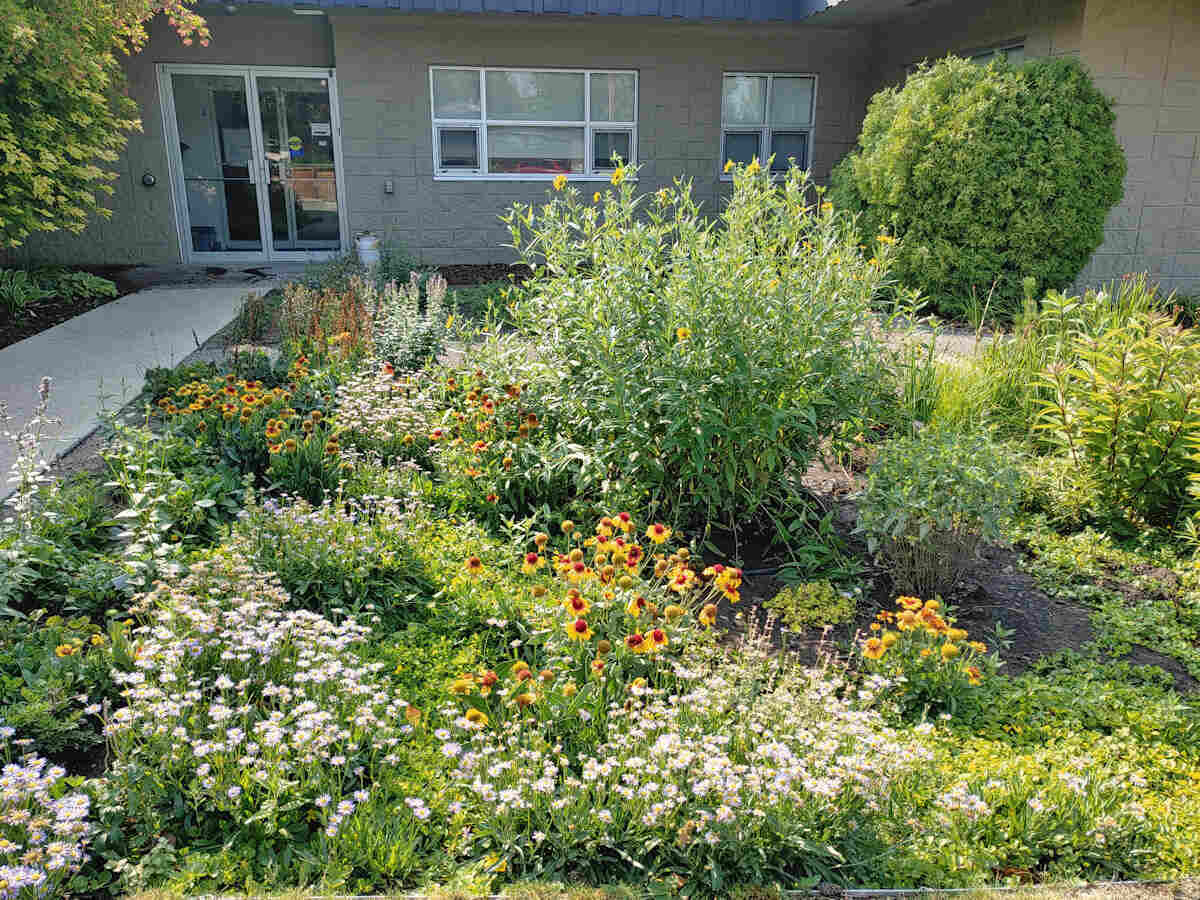
A rain garden could be the answer if repeated rains have turned your lawn into patches of puddles or small wading pools. Rain gardens are landscaped areas that reduce runoff and filter contaminants to protect nearby lakes and streams. As a bonus, rain gardens require less maintenance than a lawn and need few or no chemicals. Here’s how to build a rain garden in six steps.
What a Rain Garden Does
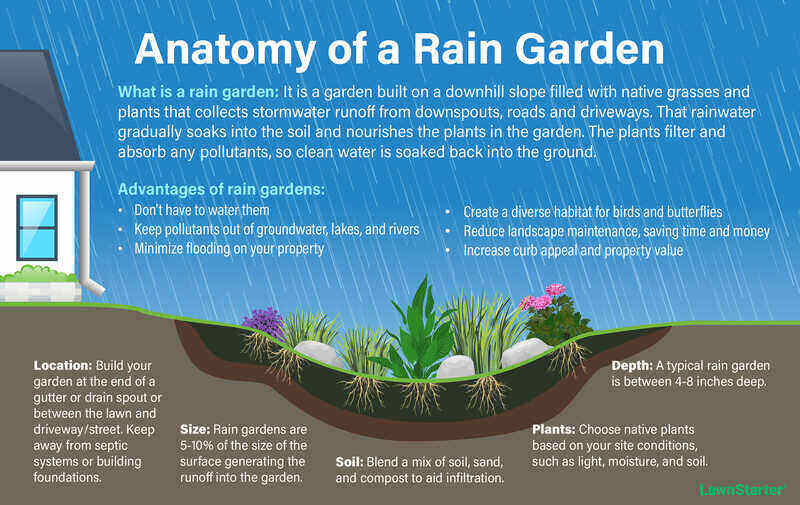
Also called a bioretention area or stormwater garden, a rain garden is a landscaped area that catches and filters stormwater runoff from impervious surfaces such as driveways, parking lots, and patios.
Capturing surface runoff and filtering it, rather than sending it through the stormwater system, helps improve water quality in several ways.
Rain gardens:
- Provide environmental protection for local waterways by filtering toxins such as pesticides, fertilizer, and motor oil.
- Establish a habitat for valuable pollinators.
- Alleviate flooding and drainage issues.
- Add a layer of stormwater management that protects local aquifers from overflowing.
“A rain garden solves a landscape problem,” explains Paula Gross, adjunct professor of horticulture at Central Piedmont Community College. “It’s not just pretty; it is part of an ecosystem that can have a positive impact on the environment.”
How to Build a Rain Garden in 6 Steps
Note: Check with your local water conservation district for specifics on how far to place a rain garden from the foundation, as advice on this may vary from place to place.
When designing your rain garden, keep your end goals in mind. Pay attention to how your garden looks from the street and your home or near your patio. Think about how your rain garden can smoothly integrate into your current landscape and how it’ll affect future projects.
Follow these six steps to establish a rain garden in your landscape:
1. Select a Location
The ideal spot to build a rain garden is close enough to your house, where it can capture water running off the roof but not risk damaging your foundation due to hydrostatic pressure. Gross suggests choosing a spot at least 10 feet from any foundations to prevent saturated soil from threatening the structure.
You can also choose a spot farther afield and direct downspouts toward the garden. The ideal places to put rain gardens are in low-lying or naturally occurring depressions where rainwater flows. Here’s what you need and what to avoid when picking the perfect spot for your rain garden.
What to look for:
- Distance: A minimum of 10 feet from foundations and 50 feet from septic systems.
- Utilities: Call 811. They’ll mark where underground utilities are for free.
- Drainage: Good drainage is critical. Perform a simple percolation or infiltration test to determine if the type of soil you have is suitable for a rain garden. Sandy soils are best, while clay soils don’t drain well.
- Sun: Pick a spot with at least partial, and preferably full, sun.
- Size: Consider the size of the roof or other impervious surfaces that drain to the downspout and the distance between the downspout and the rain garden.
A rain garden’s longest length should be perpendicular to the land’s slope and curved. Divide the rain garden area by the width, which will give you the length.
Example: A 180 square feet rain garden that is 10 feet wide equals 18 feet long.
The garden size is up to you, but the Wisconsin Department of Natural Resources estimates that a typical residential rain garden runs 100-300 square feet. Your local Extension office can provide guidance based on your location.
- Depth: A typical rain garden ranges from four to eight inches deep. Greater than eight inches deep, and the water may take too long to drain or is a tripping hazard when dry. Less than four inches deep, the garden will need to cover a large area to endure heavy rain.
What to avoid:
- Pooling: If an area turns into a pond every time it rains and drains slowly, there are better spots than this one. Poor drainage will be a problem. Think about leveling your yard or making that area a koi pond.
- Trees: Roots from nearby trees can make digging harder, and damage to the roots could kill the tree.
- Overflow: If your garden catches overflow from the neighbor’s yard, it may drain less quickly.
Pro Tip: Rain gardens will not work when the seasonal high water table is less than 24 inches below the soil surface because it will prevent absorption.
2. Prepare the Site
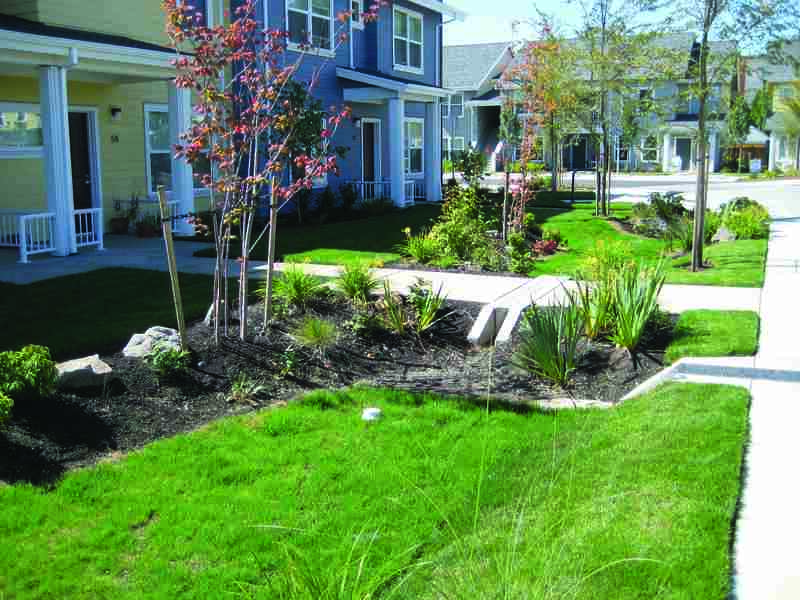
Frankie Barker with the Mat-Su Borough walks the perimeter of the large in-progress rain garden installation at Palmer Senior Center in south-central Alaska. Credit: USFWS/Katrina Mueller
A well-designed rain garden can filter up to 1 inch of rainfall in only 4 hours. Here’s how to prepare your site and get started filtering the rain on your property.
- Outline your rain garden area with rope, landscaping flags, or a marking spray paint. The berm around the perimeter creates walls that will hold the water when it rains.
- Remove all of the grass. Your options include cutting the sod to plant elsewhere or killing the grass before you start to make digging easier. Avoid chemical herbicides as this will possibly damage your new plants.
- Dig out the area until the center is the lowest point and the sides form a gentle slope toward the middle.
- Remove soil until the bottom portion is 12 inches deep, and make it level.
- Use the extra dirt to build up the berm on the downhill side. The berm’s top should not be higher than the rain garden’s uphill border.
- Spread 2 to 4 inches of compost over the surface, then mix the organic material into the rain garden soil.
- Remove soil until the bottom portion is 12 inches deep, and make it level.
3. Direct Downspouts
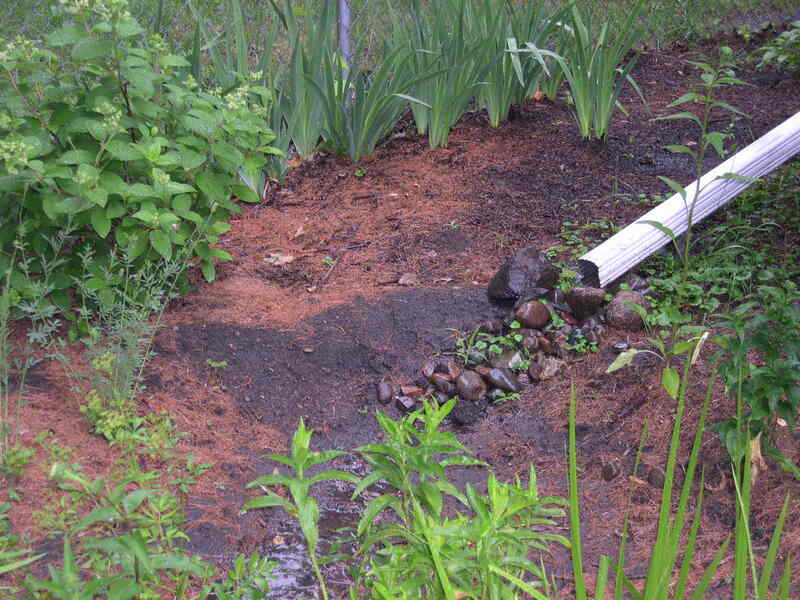
Guide water from gutters and downspouts toward your planting site. “You want to purposely direct rainwater into the garden, not just have it capture the rain that falls,” Gross says.
Here are a few ways to direct your water flow towards a rain garden and improve your drainage:
- Attach extenders: To guide water away from your home, connect a vinyl extender to downspouts.
- Build a French drain: Trenches, also known as channel drains, are dug up to 2 feet deep and lined with gravel. A perforated pipe is laid on the rock, and the trench is backfilled with dirt or stones.
- Create a swale: Swales are familiar sights along highways. They are drainage ditches or sloped and marshy portions of the land. Adding inexpensive pea gravel will improve your swale.
- Dig a dry creek bed: An arroyo, or dry creek bed, is a shallow trench filled with stone, like river rock.
4. Pick the Right Plants
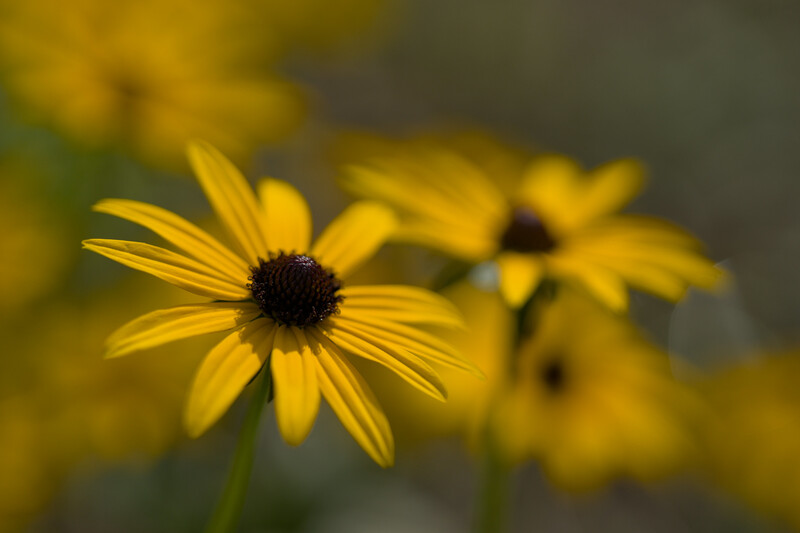
When choosing plants for your rain garden design, think about height, texture, colors, and when your plants bloom to create a focal point that’s attractive year-round. To help prevent erosion, surround the edges of the rain garden with landscape rocks.
Divide your rain garden into three sections:
Top: Because the top of your rain garden is rarely wet for extended periods, choose plants like low-growing shrubs and perennials that thrive in drier regions. Wildflowers and decorative grasses are also good options.
Sides: Plants with robust root systems that can withstand occasional puddles work for the sidewalls of rain gardens to stabilize the soil and stop erosion. Perennials are a good choice here. Ferns also work for rain gardens that have some shade.
Bottom: A good rain garden design captures rainwater, so your plant selection must include species that can withstand deluges and droughts, like native grasses and sedges.
Plant Suggestions
We have provided a few examples of rain garden plants, but there are many benefits to incorporating native species into your landscape. The main reason is that wildflowers and native plants have evolved to adapt to these alternating wet and dry conditions.
Perennials: You don’t have to replant native perennials every year, and they will display bright colors, various textures, and scents to beautify your landscape.
- Black-eyed-Susan (Rudbeckia hirta)
- Cardinal flower (Lobelia cardinalis)
- Asters (Aster)
Grasses and sedges: For the rain garden, there are some native grasses and sedges that are especially well suited to handle rainwater runoff. The landscape designs that incorporate sedges and grasses tend to look a little unkempt and less formal, Gross adds.
- Switchgrass (Panicum virgatum)
- Fox sedge (Carex vulpinoide)
- Sedge (Carex spp.)
- Horsetail (Equisetum spp.)
- Sweet flag (Acorus spp.)
- Bushy beard (Andropogon glomeratus)
- Swamp milkweed (Asclepias incarnata)
Trees and bushes: Place your bigger plants, such as flowering shrubs and trees, first, then fill in the spaces around them with other, smaller plants. Evergreens or trees that bloom in winter can give your garden four seasons of color.
- Pacific ninebark or Common ninebark (Physocarpus capitatus or Physocarpus opulifolius)
- Redbud (Cercis canadensis)
- Winterberry (Ilex verticillata)
5. Maximize Mulch
A layer of organic mulch covering the topsoil in your rain garden helps the soil retain moisture and prevents weeds from sprouting up. Apply two to three inches of mulch. Over time, check the depth of the mulch and add more as needed.
Mulch costs range from $2 to $5.50 a bag, but many cities offer free mulch. Good choices for rain garden mulch include:
- Pine straw
- Wood chips
- Shredded wood
Check out our article to learn the differences between pine straw and wood mulch so you can make the best choice for your garden.
Pro Tip: Pine bark and straw are too light for rain gardens and will float away.
6. Maintain
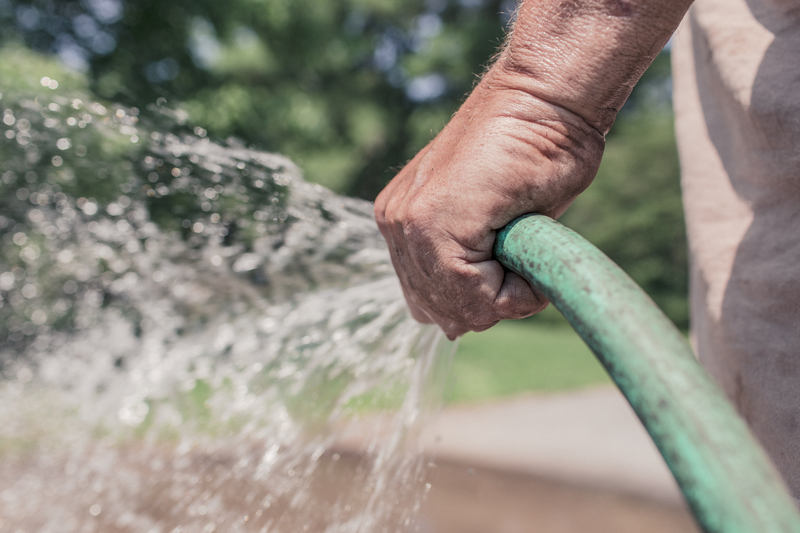
Like other landscape features, a rain garden requires maintenance to thrive, especially in the beginning. But as the plants mature, there will be less upkeep needed.
- Weeding: In the first year or two, you’ll need to pull up any weeds that snuck into your garden.
- Watering: Water your rain garden plants once a week for the first three weeks after planting. Then, you’ll need to water deeply as needed during the dry season. Once established, rain gardens require little or no watering.
- Pruning: Prune to remove dead limbs or tattered-looking plants in the spring.
- Fertilizing: If you use native plants, your rain garden won’t usually need fertilizer.
Pro Tip: Install your rain garden just before the rainy season to let Mother Nature do the first couple months of watering for you.
Local Support, Cost-Saving Incentives
A few cities offer grants or cost-share programs to encourage homeowners to establish rain gardens in their landscapes.
- In Northfield, Minn., homeowners can apply to be reimbursed for 50% of the cost of their rain gardens, up to $250.
- Lincoln, Neb. offers homeowners a rebate of up to $2,000 for “rainscaping” projects, including rain gardens.
Even if your community does not offer rebates, it may have a pilot program and offer advice on local plants — and encouragement.
Cities with informational support include:
- Austin
- Charlotte
- Chicago
- Detroit
- Los Angeles
- Nashville
- New York City
- Phoenix
- San Antonio
- San Diego
- San Jose
FAQ: How to Build a Rain Garden
No. Mosquitoes need 24 hours to complete their breeding cycle. If your rain garden has sufficient drainage, it should not have standing water for that long.
In addition to filtering pollutants from runoff, rain gardens provide other benefits:
● Provide food and shelter for wildlife
● Reduce erosion
● Replenish groundwater sources
Plant your varieties in groups of three to seven similar plants close together. It will look better than individual ones. Think about what they’ll look like when grown and how much space they’ll take up (height, width) and plan accordingly.
When to Call a Professional
If you need help deciding where a rain garden should go in your yard, you’ll most likely need the assistance of a professional landscaper. If you design and build a rain garden, you don’t want it to be in an undesirable location and not work correctly.
A rain garden is an easy, affordable, and environmentally friendly solution to the stormwater runoff and erosion issues on your property, whether you do it yourself or hire a professional.
Main Image Credit: Maureen Flynn-Burhoe / Wikimedia Commons / CC BY 2.0